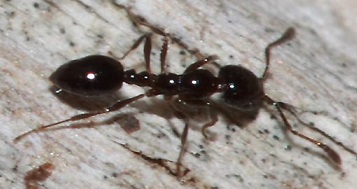Facts
There are many factors that make the Monomorium minimum an interesting eusocial species to study. For instance, the M. minimum is the most frequent and infamous home invader of ants (Smith 1965, Pestnet 2012). This makes the M. minimum important to study because with more information about these ants, people will learn how to identify them, why they come into their homes, and where they are most likely to make a nest. More knowledge about these popular pests will allow people to know what they can expect, and how to best get rid of them.
 Another interesting fact about the M. minimum is that it can survive
in extremely high altitudes (Smith 1965). According to Van Pelt, the M.
minimum has been discovered at higher elevations on certain peaks called
Blue Ridge (Smith 1965). The survival of these ants at such high
altitudes shows that it is highly adaptive and can survive under various
environmental conditions. This shows how cool and different the species
M. minimum is from the typical ant.
Another interesting fact about the M. minimum is that it can survive
in extremely high altitudes (Smith 1965). According to Van Pelt, the M.
minimum has been discovered at higher elevations on certain peaks called
Blue Ridge (Smith 1965). The survival of these ants at such high
altitudes shows that it is highly adaptive and can survive under various
environmental conditions. This shows how cool and different the species
M. minimum is from the typical ant.
M. minimum also has an interesting diet feeding on a variety of foods. One of the foods that M. minimum eats that is fairly shocking is deceased insects (Adams and Traniello 1981). This is fascinating because they are eating other arthropods that are more than twice their body size. They are able to eat these giants compared to themselves because these arthropods can't put up a fight against them. They are already dead. They also use the technique of breaking apart the larger dead insect in order to carry it back to their homes to eat.
Another interesting fact about M. minimum is that their colonies can vary in magnitude from a medium size to a massive population where the colony can have a vast amount of females that can bear their young (Smith 1965). This fact shows that this species has the ability to form in large groups because the many females can increase the population size. This is beneficial to the ant population because they have a better chance of surviving and producing offspring that can survive as well.
Males
and females with wings have been identified during the summer months of
June through August (Smith 1965, Texas A&M AgriLife
Research Extension 2010). This fact is interesting
because it shows that the ants are more likely to be around when the
climate is warmer. Not sighting the M. minimum in the winter months
might explain how the animals have a difficult
 time surviving in chilly
temperatures and snowy weather conditions. The spotting of M. minimum
only in the summertime is important because it could help explain the
climate and weather conditions that these ants have the most success
with survival.
time surviving in chilly
temperatures and snowy weather conditions. The spotting of M. minimum
only in the summertime is important because it could help explain the
climate and weather conditions that these ants have the most success
with survival.
The ant M. minimum is a familiar scavenger ant often seen throughout the communities in which it resides (Pearce-Duvet et al. 2011). This is compelling because people are most likely to have seen this particular ant and may have an interest about its lifestyle. It also shows how abundant the ant’s population is displaying its exceptional ability of surviving and thriving.
The ant M. minimum has a competitive edge over other ant species. For
example, it can cause the ants of Solenopsis invicta to die at a quicker
rate than the ant species Pheidole dentata, Solenopsis molesta and
Tetramorium bicarinatum (Rao and Vinson 2007). This fact is alluring
because it shows the ability of the M. minimum’s dominance over other
species, and their ability to take over different ant species with ease.
Click here for References.
Click here to return to the Home page.